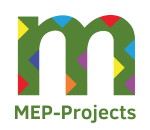- 28 August, 2024
- Francisco Gallego
- Comment: 0
- News

GREEN ENERGY ECONOMY: OPTIMISATION STRATEGIES FOR RENEWABLE INVESTMENTS

In MEP-Projects, the transition towards a green energy economy is essential, and maximizing the return on investments in renewable energy requires a technical and strategic approach. Opportunities in this sector are vast, but to fully capitalize on them, it is crucial to conduct detailed profitability analyses, effectively manage risks, and apply the latest technological innovations.
Profitability Assessment and Financial Models
Profitability analysis is the first step to ensuring the viability of a renewable energy project. Methodologies such as discounted cash flow (DCF) are used to calculate the net present value (NPV), adjusting future cash flows for the cost of capital and associated risks. This process is critical in determining whether a project will generate a positive and sustainable return in the long term.
Additionally, the internal rate of return (IRR) is employed to evaluate the project’s efficiency compared to other potential projects or investor expectations. These financial tools allow for the prioritization and selection of projects that are not only sustainable from an environmental perspective but also viable and profitable.
Leveraging Public Policies and Incentives
The regulatory environment and government incentives are crucial in determining the viability of renewable energy investments. Programs such as feed-in tariffs, tax credits, and power purchase agreements (PPAs) play a fundamental role in reducing initial costs and ensuring stable income. These incentives not only reduce financial risks but also create a more attractive environment for investments.
PPAs, in particular, are essential for securing a predictable revenue stream, facilitating financing, and reducing exposure to energy market volatility. Additionally, carbon markets and emission trading schemes provide additional opportunities to generate revenue, thereby improving the overall profitability of projects.
Management of Technical and Market Risks
Risk management is a key aspect of the success of renewable energy projects. An exhaustive analysis of technical risks, such as variability in natural resource availability, is conducted, and advanced simulations are performed to model different scenarios. This planning allows for anticipating and mitigating the effects of fluctuations in energy production on revenue.
Furthermore, market risks, such as energy price fluctuations and regulatory changes, are considered. Hedging and diversification strategies are applied to protect investments and ensure more stable returns. The selection of proven and scalable technologies is also fundamental to ensuring that projects maintain their competitiveness and efficiency over time.
Technological Innovation and Operational Efficiency
Technological innovation is a central component in optimizing project performance. Smart grids and energy management systems based on artificial intelligence are implemented to improve operational efficiency and system flexibility. These technologies allow for maximizing the utilization of energy resources and reducing operational costs.
Energy storage is another critical element, as it facilitates the management of the intermittency of renewable sources such as solar and wind, ensuring a continuous and stable supply. Additionally, predictive maintenance technologies, supported by big data and remote monitoring, are used to identify and resolve issues before they become costly failures, optimizing uptime and extending the life of installations.
Environmental and Social Impact Assessment
At MEP-Projects, sustainability is measured not only in economic terms but also in terms of environmental and social responsibility. Projects are developed with rigorous environmental impact assessments (EIAs) to minimize any adverse effects on the natural environment. Furthermore, close collaboration with local communities ensures that projects provide tangible benefits and contribute positively to local social and economic development.
This comprehensive approach reinforces the social acceptance of projects, creating a positive impact for both investors and the communities involved.
Conclusion
Maximizing the return on investments in renewable energy at MEP-Projects requires a comprehensive approach that combines rigorous financial analysis, effective risk management, and the adoption of advanced technologies. This approach enables the development of projects that are not only profitable but also sustainable and resilient, contributing to a greener and more secure energy future for all.
Made by Vicente Benítez (EICA Design Engineer)

